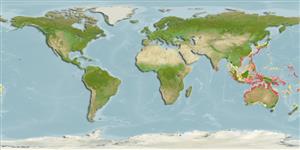>
Tetraodontiformes (Puffers and filefishes) >
Monacanthidae (Filefishes)
Etymology: Pseudomonacanthus: Greek, pseudes = false + Greek,monos = one + Greek, akantha = thorn (Ref. 45335).
Environment: milieu / climate zone / depth range / distribution range
Ekologi
marina revassocierade. Tropical
Eastern Indian Ocean: Indonesia and northwestern Australia. Reported from Papua New Guinea (Ref. 6771).
Size / Vikt / Age
Maturity: Lm ? range ? - ? cm
Max length : 35.0 cm SL hane/ej könsbestämd; (Ref. 48594)
Inhabits trawling grounds (Ref. 3132).
Life cycle and mating behavior
Maturities | Reproduktion | Spawnings | Egg(s) | Fecundities | Larver
Allen, G.R. and R. Swainston, 1988. The marine fishes of north-western Australia: a field guide for anglers and divers. Western Australian Museum, Perth. 201 p. (Ref. 3132)
IUCN Red List Status (Ref. 130435)
Threat to humans
Harmless
Human uses
Verktyg
Special reports
Download XML
Internet-källor
Estimates based on models
Preferred temperature (Ref.
123201): 24.6 - 29.3, mean 28.3 °C (based on 1550 cells).
Phylogenetic diversity index (Ref.
82804): PD
50 = 0.6250 [Uniqueness, from 0.5 = low to 2.0 = high].
Bayesian length-weight: a=0.01995 (0.00943 - 0.04220), b=2.93 (2.75 - 3.11), in cm total length, based on LWR estimates for this (Sub)family-body shape (Ref.
93245).
Trofisk nivå (Ref.
69278): 2.8 ±0.4 se; based on size and trophs of closest relatives
Resiliens (Ref.
120179): Mellan, lägsta populationsfördubblingstid 1,4-4,4 år (Preliminary K or Fecundity.).
Fishing Vulnerability (Ref.
59153): Low to moderate vulnerability (33 of 100).
Nutrients (Ref.
124155): Calcium = 41.5 [17.2, 101.9] mg/100g; Iron = 0.603 [0.280, 1.414] mg/100g; Protein = 18.1 [15.9, 20.3] %; Omega3 = 0.0809 [, ] g/100g; Selenium = 25.2 [10.8, 57.6] μg/100g; VitaminA = 58.5 [15.2, 210.3] μg/100g; Zinc = 1.28 [0.82, 2.07] mg/100g (wet weight);
